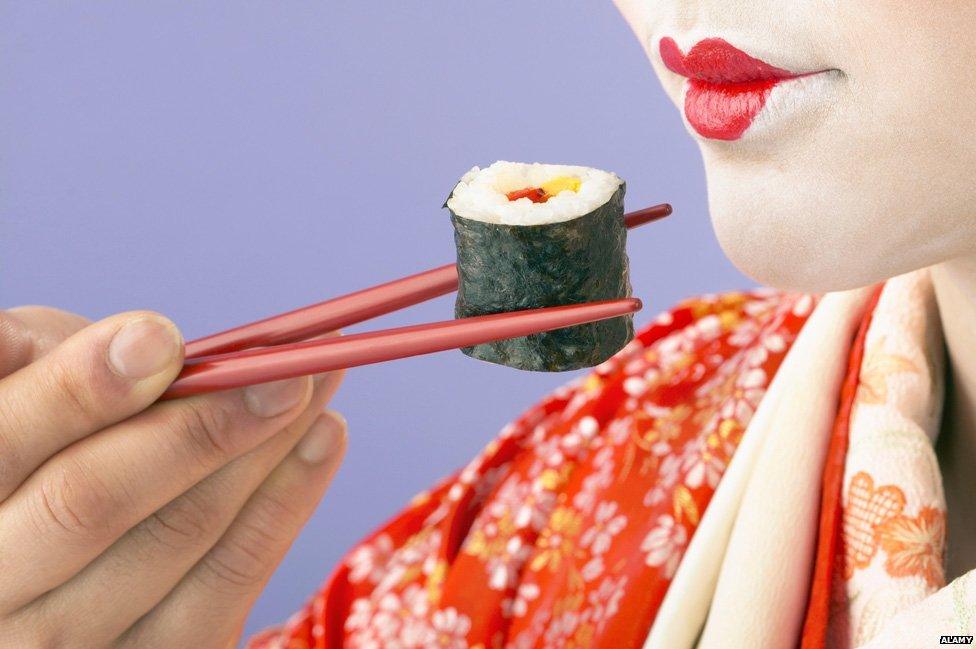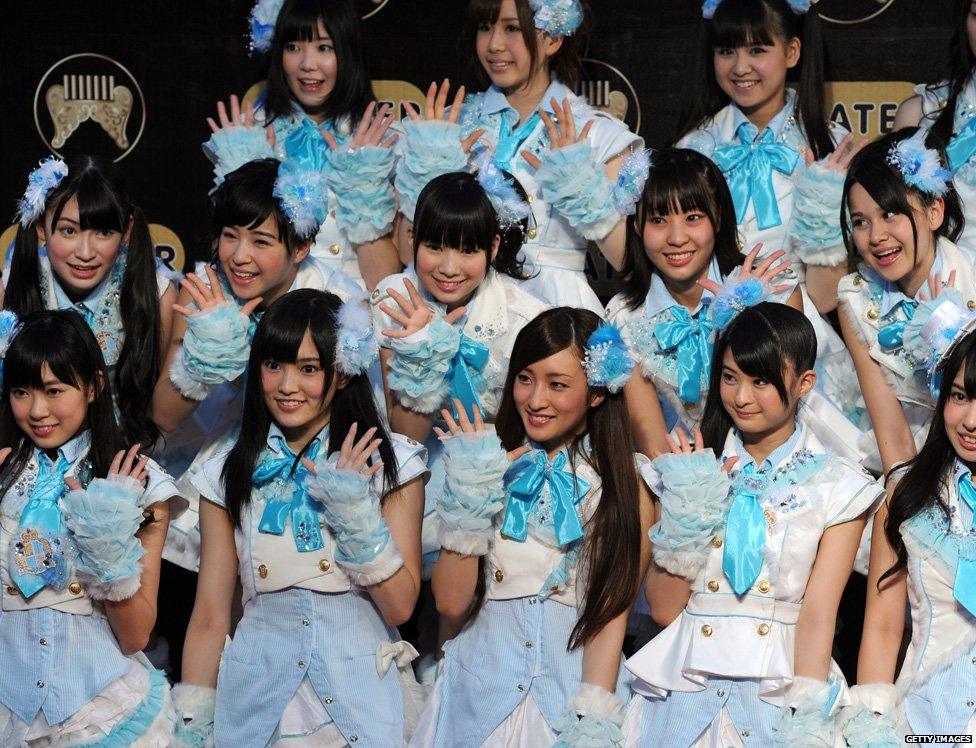Three Western myths about Japan
- Published

National and racial stereotypes are often hard to dispel, but in the case of Japan, argues Dr Chris Harding of Edinburgh University, people in the West seem particularly determined to cling on to a set of long-established myths.
Landing in Japan for the first time 10 years ago, I couldn't wait to get out of Narita airport's dull beige arrivals area and into the real Japan.
Pretty soon, I felt sure, I would be lost in the intense verdant greens of paddy fields and forests, the steaming waters of natural hot springs. A sip of green tea would set me up for an afternoon of meditation in some old Buddhist temple tucked in among fragrant cedars. And then as night fell, a bullet train would zoom me into central Tokyo for a joyously baffled embrace of its Blade Runner futurism and crazy entertainments.
None of these fantasies survived a three-hour gridlocked bus ride into Tokyo, the motorway's faceless concrete sidings occasionally dipping to allow views out across faceless concrete high-rises.

I drank sugary milk marketed as "ice coffee" with the Japanese acquaintance who'd come to meet me. We established that though his family was "technically Buddhist" he had no idea what that meant and he associated temples with school trips and dead people.
As we lapsed into silence, I considered asking Japan's tourist board for my money back. I had been mis-sold Japan!
Later I realised they were just doing their job, generating tourist dollars with the material available to them - one extremely gullible young man, plus a century and a half of Western misrepresentations of Japan.
Here are three of the best misrepresentations - or worst, depending on your point of view.
1: Japan is inherently strange
"To find oneself suddenly in a world where everything is upon a smaller and daintier scale than with us - a world of lesser and seemingly kindlier beings, all smiling at you as if to wish you well - a world where all movement is slow and soft, and voices are hushed… this is surely the realisation, for imaginations nourished with English folklore, of the old dream of a World of Elves."
That was the writer Lafcadio Hearn, 125 years ago. Across the century that followed, countless Westerners visited and worked in Japan. Japanese culture became readily available to us in literature and film. And yet despite all this, the keynote of the brilliant 1980s travelogue Clive James in Japan was a drily comic bewilderment at everything.
When he buys a snack on a bullet train, thinking that it might be a ham sandwich (while also noting that it looks like a pair of tights) it turns out to be a powerful-smelling dried squid - "dried and ironed" he speculates. Revolted, James stuffs the snack into the seat pocket, external and heads off for his next misadventure with the carriage's on-board telephone.
Clive James wasn't alone. Soon came Michael Palin, who shared with James a tendency to observe and commentate on the Japanese from a distance, without really engaging directly.
Michael Palin tries his hand at karaoke (1991)
Maybe I shouldn't gripe. This was light entertainment, after all. But whereas most travel documentaries try to offer a portrait of a place, helping viewers or listeners get to know it, when it came to the Japanese the underlying message was: "It can't be done! They're completely inscrutable!"
Why? One reason may be that in a world where true strangeness and surprise have become rare and precious commodities, we have to find them somewhere. Financial Times journalist David Pilling quotes a friend who said Japan was the most alien place she'd been that had good plumbing.
At the same time, Japan offers us a mirror in which to look at ourselves. We say "Japan is…", but we're really asking a question: "Are we…?" The Japanese are dainty, kindly, soft - are we coarse and hard-hearted? Japan is hobbled by a group mentality that trumps individualism - how free are we…?
2. The Japanese are dangerous

Atrocities committed during World War Two gave the Japanese military a powerful reputation for cruelty. But a notion has long bubbled away in the West that the Japanese as a people are inherently unpredictable and dangerous - the famous gentility masking something menacing. This goes back at least as far as the 1850s, when British travellers and diplomats saw Japanese tolerance of their presence in the country morph into sporadic attacks against Westerners and their Japanese assistants. They linked the violence to the particular outlook of the samurai class, and the association stuck.
Some of these early ideas about the samurai were in part Japanese creations - fantasies concocted for a Western readership willing to pay good money for exotic tales of violence and sex. World War Two gave the legend another twist: the chivalrous, highly ethical elements of this samurai fantasy were lost, and what remained was the unthinking loyalty, the refusal to surrender, the indifference towards death - and others' lives.
You can hear the results of all this in Alan Whicker's nervous postwar musings on karate.
Alan Whicker describes the discipline of karate
3. Japanese women are submissive
Japan has been seen as the land that feminism forgot. Both Japanese and Western commentators have tended to see the geisha girl as the ideal of Japanese womanhood - attractive and subtle, subservient to men, but clever enough to be good company. Then there was the influential American anthropologist of the 1940s, Ruth Benedict, who heard that Japanese girls were given just enough education so they could put their husbands' books back the right way up once they'd finished dusting them. By the 1960s, for Western men unsure what to make of the rise of women's liberation movements, all of this appeared deeply attractive.
Alan Whicker on Japanese model and pop-star Linda
Japanese women even received the ultimate British seal of approval in 1967, as Mie Hama became Bond-girl "Kissy Suzuki" in You Only Live Twice. Given the low-down on domestic arrangements in Japan by his male host - women are inferior to men, they're happy with that, and they live to serve - Bond gives his blessing: "I think I'll retire here…"
And if you think that nothing of this sort could possibly go on in the early 21st Century, then you haven't been paying attention to Japanese pop culture, and the success of Japanese pop behemoth AKB-48, external.

Yes, 48 young girls (in the original line-up, though the group has since expanded), forbidden from having boyfriends and content instead to smile and dance around in bikinis or mock military uniforms or really whatever a paying public of - critics would argue - socially inadequate young and middle-aged men want to see.
All in all, this particular myth about Japan is simply worth too much to too many people - Western men mourning the passing of the patriarchy, Western feminists looking for sisters to save in Asia, corporate Japan chasing the under-deodorised male dollar (or Yen) - for it to be revised any time soon. It's the perfect example of how diverse interests come together over time to create misrepresentations with a surprisingly long shelf life.

More from the Magazine
Seventy years ago many Japanese people in occupied Tokyo after World War Two saw US troops as the enemy. But tens of thousands of young Japanese women married GIs nonetheless - and then faced a big struggle to find their place in the US.

You can listen to Misunderstanding Japan, produced for the BBC Radio 4 programme on Archive on 4, on the BBC iPlayer.
Dr Christopher Harding is a writer and broadcaster who teaches Japanese and Indian history at the University of Edinburgh. He blogs at www.theboredomproject.com and tweets as @drchrisharding.
Subscribe to the BBC News Magazine's email newsletter, external to get articles sent to your inbox.